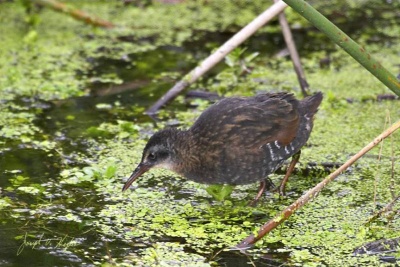m |
(taxon, refs, GS) |
||
| (One intermediate revision by the same user not shown) | |||
| Line 18: | Line 18: | ||
*''R. l. limicola'' - Southern [[Canada]] and [[US]]; winters to Baja and [[Guatemala]] | *''R. l. limicola'' - Southern [[Canada]] and [[US]]; winters to Baja and [[Guatemala]] | ||
*''R. l. friedmanni'' - South-eastern [[Mexico]] (Puebla, México, Veracruz and Chiapas) | *''R. l. friedmanni'' - South-eastern [[Mexico]] (Puebla, México, Veracruz and Chiapas) | ||
| − | *''R. l. aequatorialis'' - | + | *''R. l. aequatorialis'' - Andes of extreme southern [[Colombia]] (Nariño and extreme western Putumayo) and of [[Ecuador]] (south to northern Loja) |
| + | *''R. l. meyerdeschauenseei'' - coast of [[Peru]] (La Libertad to Arequipa); possibly formerly occurred north to northwestern [[Ecuador]] (Imbabura) | ||
| + | The last two subspecies are sometimes considered a separate species, "Ecuadorian Rail". | ||
==Habitat== | ==Habitat== | ||
Shallow freshwater marshes with emergent vegetation. | Shallow freshwater marshes with emergent vegetation. | ||
| Line 27: | Line 29: | ||
The nest is a platform composed of cattails and other plants in a dry area in the marsh. The clutch consists of 5 to 13 eggs. Both adults care for the young. | The nest is a platform composed of cattails and other plants in a dry area in the marsh. The clutch consists of 5 to 13 eggs. Both adults care for the young. | ||
==References== | ==References== | ||
| − | #{{Ref- | + | #{{Ref-Clements6thOct22}}#{{Ref-GillDonskerRasmussen22V12.2}}#Wikipedia |
{{ref}} | {{ref}} | ||
==External Links== | ==External Links== | ||
| − | {{GSearch|Rallus | + | {{GSearch|"Rallus limicola" {{!}} "Virginia Rail" {{!}} "Ecuadorian Rail"}} |
| + | {{GS-checked}}<br /><br /> | ||
[[Category:Birds]][[Category:Rallus]] | [[Category:Birds]][[Category:Rallus]] | ||
Latest revision as of 19:17, 6 January 2023
Includes Ecuadorian Rail
- Rallus limicola
Identification
- Rufous breast
- Long, slightly decurved bill
- Red bill and legs
- Grey face
- Black and white barring on flanks
- Brown streaking on back
Similar Species
Similar to King Rail, but king rail is much larger, with light brownish bill and legs, less grey in face.
Distribution
Nova Scotia to California and North Carolina; southwestern Colombia to western Peru; southern Chile and Argentina.
Taxonomy
Subspecies1
- R. l. limicola - Southern Canada and US; winters to Baja and Guatemala
- R. l. friedmanni - South-eastern Mexico (Puebla, México, Veracruz and Chiapas)
- R. l. aequatorialis - Andes of extreme southern Colombia (Nariño and extreme western Putumayo) and of Ecuador (south to northern Loja)
- R. l. meyerdeschauenseei - coast of Peru (La Libertad to Arequipa); possibly formerly occurred north to northwestern Ecuador (Imbabura)
The last two subspecies are sometimes considered a separate species, "Ecuadorian Rail".
Habitat
Shallow freshwater marshes with emergent vegetation.
Behaviour
Diet
The diet includes insects and aquatic animals.
Breeding
The nest is a platform composed of cattails and other plants in a dry area in the marsh. The clutch consists of 5 to 13 eggs. Both adults care for the young.
References
- Clements, J. F., T. S. Schulenberg, M. J. Iliff, T. A. Fredericks, J. A. Gerbracht, D. Lepage, S. M. Billerman, B. L. Sullivan, and C. L. Wood. 2022. The eBird/Clements checklist of Birds of the World: v2022. Downloaded from https://www.birds.cornell.edu/clementschecklist/download/
- Gill, F, D Donsker, and P Rasmussen (Eds). 2022. IOC World Bird List (v 12.2) DRAFT. Doi 10.14344/IOC.ML.12.2. http://www.worldbirdnames.org/
- Wikipedia
Recommended Citation
- BirdForum Opus contributors. (2024) Virginia Rail. In: BirdForum, the forum for wild birds and birding. Retrieved 18 May 2024 from https://www.birdforum.net/opus/Virginia_Rail
External Links
GSearch checked for 2020 platform.





